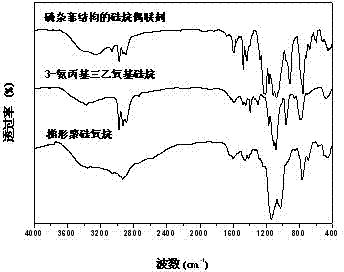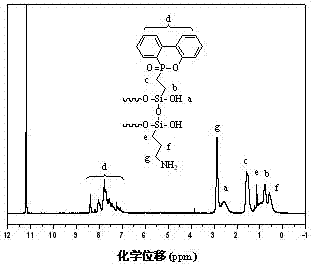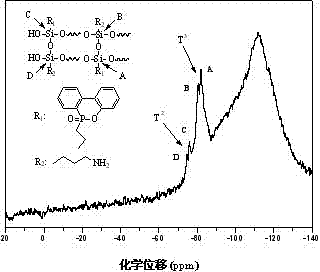Trapezoidal polysiloxane and preparation method thereof
A polysiloxane and trapezoidal technology, applied in the field of trapezoidal polysiloxane and its preparation, can solve the problems of cumbersome synthesis process and low yield, achieve broad application prospects, high phosphorus content, and increase yield
- Summary
- Abstract
- Description
- Claims
- Application Information
AI Technical Summary
Problems solved by technology
Method used
Image
Examples
Embodiment 1
[0037](1) Under nitrogen protection, 1.9g of 9,10-dihydro-9-oxa-10-phosphaphenanthrene-10-oxide (DOPO), 1.9g of vinyltriethoxysilane, 0.08g of Add nitrogen diisoheptanonitrile and 10 mL dimethylformamide into the flask, and react at 120° C. for 2 hours. After the reaction, the solvent was distilled off under reduced pressure to obtain a silane coupling agent containing a phosphaphenanthrene structure.
[0038] (2) Under the protection of nitrogen, 3g of silane coupling agent containing phosphaphenanthrene structure, 3g of 3-aminopropyltriethoxysilane, 0.1g of sodium hydroxide in methanol (0.1mg / mL), 2mL of Ionized water and 16mL of methanol were added to the flask and reacted at room temperature for 0.5 hours; then the temperature was raised to 40°C for 10 hours. After the reaction, the product was slowly dropped into methanol at a volume ratio of 1:5 to precipitate a white powder, which was filtered, washed, and dried to obtain a trapezoidal polysiloxane with a molecular ...
Embodiment 2
[0050] (1) Under the protection of argon, 2.4g 9,10-dihydro-9-oxa-10-phosphaphenanthrene-10-oxide, 1.9g vinyldimethoxysilane, 0.7g azobisiso Butyronitrile, 5mL methanol, and 5mL acetonitrile were added to the flask, and reacted at 60°C for 20 hours. After the reaction, the solvent was distilled off under reduced pressure to obtain a silane coupling agent containing a phosphaphenanthrene structure.
[0051] (2) Under the protection of argon gas, 3g of silane coupling agent containing phosphaphenanthrene structure, 9g of 3-aminopropyltrimethoxysilane, 0.1g of potassium hydroxide in methanol solution (0.1mg / mL), 2mL Deionized water, 15 mL of acetone, 15 mL of acetonitrile and 10 mL of chloroform were added to the flask, and reacted at room temperature for 1.5 hours; then the temperature was raised to 55° C. for 7 hours. After the reaction, the product was slowly dropped into methanol at a volume ratio of 1:10 to precipitate a white powder, which was filtered, washed, and drie...
Embodiment 3
[0053] (1) Under the protection of helium, 2.06g of 9,10-dihydro-9-oxa-10-phosphaphenanthrene-10-oxide, 1.9g of vinyltriethoxysilane, 0.02g of azobis Isobutyronitrile, 0.02g of azobisisoheptanonitrile and 20mL of dichloromethane were added to the flask, and reacted at 60°C for 10 hours. After the reaction, the solvent was distilled off under reduced pressure to obtain a silane coupling agent containing a phosphaphenanthrene structure.
[0054] (2) Under the protection of helium, 3 g of phosphaphenanthrene structure-containing silane coupling agent, 3 g of 3-aminopropyltrimethoxysilane, 0.1 g of potassium hydroxide in methanol (0.1 mg / mL), and 2 mL of Ionized water, 20mL ethanol and 20.5mL propanol were added to the flask and reacted at room temperature for 2 hours; then the temperature was raised to 50°C for 10 hours. After the reaction, the product was slowly dropped into a mixed solution of acetone, acetonitrile and chloroform to precipitate a white powder according to a...
PUM
 Login to View More
Login to View More Abstract
Description
Claims
Application Information
 Login to View More
Login to View More - R&D
- Intellectual Property
- Life Sciences
- Materials
- Tech Scout
- Unparalleled Data Quality
- Higher Quality Content
- 60% Fewer Hallucinations
Browse by: Latest US Patents, China's latest patents, Technical Efficacy Thesaurus, Application Domain, Technology Topic, Popular Technical Reports.
© 2025 PatSnap. All rights reserved.Legal|Privacy policy|Modern Slavery Act Transparency Statement|Sitemap|About US| Contact US: help@patsnap.com



